The flowering herb Tricyrtis is a member of the Liliaceae family. In nature, they are most often found in Japan and the Himalayas. According to various sources, this genus unites 10–20 species, some of them are cultivated by gardeners under the name “garden orchid”. The name of this genus comes from the Greek word translated as "three tubercles", this is due to the fact that the flower has 3 nectaries. Tricirtis is also called the “toad lily”, the fact is that there are frogs on the menu of the Filipinos, and in order to catch them, they rub their skin with the juice of this flower, since its smell attracts amphibians. Tricirtis began to be cultivated at the end of the 18th century, but it became popular only in the 20th century.
Content
- 1 Features of tricirtis
- 2 Planting tricyrtis in the open field
- 3 Caring for tricyrtis in the garden
- 4 Types and varieties of tricirtis with photos and names
- 4.1 Taiwanese tricyrtis (Tricyrtis formosana), or Formosan tricyrtis
- 4.2 Tricyrtis yellow (Tricyrtis flava = Tricyrtis yatabeana)
- 4.3 Hairy tricyrtis (Tricyrtis pilosa = Tricyrtis maculata = Tricyrtis elegance)
- 4.4 Long-legged tricyrtis (Tricyrtis macropoda)
- 4.5 Tricyrtis broadleaf (Tricyrtis latifolia = Tricyrtis bakeri)
- 4.6 Short-haired tricyrtis (Tricyrtis hirta), or tricirtis hirta (Uvularia hirta)
Features of tricirtis
Tricirtis is a perennial short-rhizome plant. Leafy shoots are straight, they are sometimes branched. Sedentary alternately located leaf plates (there are also stem-embracing ones), have an ovoid or oblong shape. The foliage is sometimes spotty. Large funnel-shaped flowers can be white, cream or yellow, they are spotty and monochromatic. Flowers are single, and they can also be part of semi-umbellate inflorescences or bundles, they are located on the tops of the shoots or in the leaf axils. At the perianth, on the outer leaves there are short sacs or spurs, which are nectaries. The fruit is an elongated box, inside of which are seeds of black or brown color.
Planting tricyrtis in the open field
What time to plant
To grow tricyrtis, you need to sow the seeds in open soil immediately after harvesting, and this is done before winter. If, for some reason, sowing is postponed until spring, then the seeds must be stratified immediately before sowing, for this they are placed on a refrigerator shelf for 6-8 weeks for vegetables. This culture is propagated by vegetative methods, which will be discussed below.
Landing rules
An area suitable for planting should be in a shaded area under large trees. On the site there should be loose forest soil saturated with leaf humus and peat. Also, this plant can be grown in black soil. It should be noted that approximately half of the day the site should be illuminated by the sun. Also, the site should be well protected from any wind, and also from drafts. Tricyrtis also react negatively to moisture stagnation in the soil. When growing late varieties, it should be borne in mind that they need very good lighting, the fact is that due to early twilight in autumn, the process of forming buds and flowers may be disrupted.
The seeds should be buried in open soil only 0.3 cm. Then the crops must be watered very carefully. Plants grown from seeds will bloom for the first time for 2-3 years.
Caring for tricirtis in the garden
Even a novice gardener can grow tricyrtis on his site, since there is nothing difficult in this. It is very good if the flowers are planted on a site that meets all the requirements of this culture. Caring for such a plant is very simple, so, you need to water it in a timely manner, feed it, weed it, loosen the surface of the soil between the bushes and pick off the wilted flowers.
How to water and feed
Despite the fact that this crop is resistant to drought, it is moisture-loving. In this regard, she should ensure systematic abundant watering, especially if there is a prolonged drought. For irrigation, use settled water, which should warm up well in the sun. It is necessary to pour water gently, at the root. When the water is completely absorbed into the soil, it is recommended to loosen its surface and, if necessary, weed. Experienced gardeners advise to cover the surface of the plot with mulch, which can be used as compost or humus, it will not only prevent the earth from overheating, moisture evaporate quickly, and weed grass grow actively, but it will also become a source of nutrients for tricirtis.
If desired, this culture can not be fed at all. But you should know that it responds very well to feeding both with organic matter and with complex mineral fertilizers. It is forbidden to use fresh manure for fertilizing.
Transfer
Very often, such a flower does not need to be transplanted, all the more so if it will systematically receive fertilizing during intensive growth and flowering. However, if tricyrtis must be transplanted, then first you will need to find the most suitable site, pay special attention to the soil, it must be acidic, and its composition includes organic matter and peat.
Reproduction of tricirtis
The propagation of this culture by the seed method is described in detail above. Simultaneously with the transplant of the bush, you can also make its division. To do this, remove the bush from the soil, remove the remnants of soil, as well as dried and rotten roots from its rhizomes. Then the bush is divided in half or into several divisions, while each of them should have shoots and roots. Places of cuts must be processed with crushed coal, then the cuttings must be planted in pre-prepared holes. The holes should be covered with fertile soil, after which the planted plants are watered abundantly.
Wintering
Tritsirtis needs shelter for the winter. To protect the bushes from frost, they should be covered with a thick layer of peat or agrofibre. In the southern regions, where the climate is mild, and winters are warm, in principle, tricyrtis can be left uncovered for the winter, but experienced gardeners still recommend doing this, as it can suffer if very little snow falls in winter.
Diseases and pests
Tricirtis has a very high disease resistance. However, if grown in heavy soil and watered very abundantly, the root system can rot due to stagnant water.For preventive purposes, sand should be added to the soil before planting during digging. And also try to develop such an irrigation system so that water in the soil does not stagnate.
Slugs and snails can harm such a plant, they not only gnaw holes in the leaf plates, but also leave sticky phosphorescent traces. You will have to collect the gastropods with your hands. It is also recommended to cover the soil surface around the bushes with a layer of coarse bark or crushed egg shells, such pests move along it with great difficulty.
Types and varieties of tricirtis with photos and names
Gardeners cultivate both species and varietal tricyrtis.
Taiwanese tricyrtis (Tricyrtis formosana), or Formosan tricyrtis
The height of the bush is about 0.8 meters. The surface of the shoots is fleecy. On the surface of green glossy oval-shaped leaf plates, there are specks of dark red color. The surface of the flowers is lilac-pink or pink-white streaked with brownish-red specks.
Tricyrtis yellow (Tricyrtis flava = Tricyrtis yatabeana)
This species is native to the mountain forests of Japan. The surface of the stem is hairy, and its height can vary from 0.25 to 0.5 meters. The apical inflorescences consist of yellow flowers, as a rule, they are monochromatic, but sometimes they are spotty. This type is currently not yet very popular among gardeners.
Hairy tricyrtis (Tricyrtis pilosa = Tricyrtis maculata = Tricyrtis elegance)
The homeland of this species is the Himalayas, while these plants can be found at an altitude of up to 2 thousand meters above sea level. The height of the bush is about 0.6-0.7 meters. On the lower surface of broadly lanceolate leaf plates there is pubescence. Apical inflorescences of whitish flowers, on the surface of which there are large specks of purple color. This type is not yet very popular with flower growers.
Long-legged tricyrtis (Tricyrtis macropoda)
In nature, this species is found in the subtropical regions of Japan and China. The height of the bush varies from 0.4 to 0.7 m. The stem is cylindrical in the upper part is shortly pubescent. The length of the stalk-enclosing leaf plates is 8–13 centimeters, and their width is 3–6 centimeters, they have an ovoid or oblong shape. The terminal and axillary inflorescences consist of white fragrant flowers, on the surface of which there are many purple spots. Flowers are shorter than pedicels.
Tricyrtis broadleaf (Tricyrtis latifolia = Tricyrtis bakeri)
The homeland of this species is the shady forests of Japan and China. The height of the bush is about 0.6 m. On the surface of the green ovoid leaf plates, there are specks of dark color, which are especially clearly visible at the very beginning of growth. This species begins to bloom earlier than other tricyrtis species. The flowers are collected in apical bundles, they are painted in green-white color, and on their surface there are specks of a darker shade.
Tricyrtis hirta (Tricyrtis hirta), or tricirtis hirta (Uvularia hirta)
This species is native to the subtropics of Japan. He is the most popular of all. The height of the bush can vary from 0.4 to 0.8 m. On the surface of the cylindrical stem, there is dense pubescence, consisting of a short pile. The length of the leaf plates is about 15 centimeters, and the width is about 5 centimeters, they have an elliptical or broad-lanceolate shape, and on their surface there is also a pubescence, consisting of short hairs. The foliage at the top of the shoot is stalk-embracing. Flowers can be single or collected in several pieces, they grow on the tops of the shoots or in the axils. There are many purple spots on the surface of the white flowers. Garden forms:
- short-haired Masamuna - the bush has no pubescence;
- short-haired black - speckles on the surface of the flowers have a darker color compared to the main species, and this variety blooms earlier.
But the most popular among gardeners are hybrids of this type of tricyrtis:
- Dark Beauty... This variety is distinguished by its resistance. The flowers are pale pink, and on their surface there are many specks of dark purple color.
- Raspberry Mousse... The flowers are brownish-purple, without specks.
- Blue Haven... The leaf plates are leathery. The large bell-shaped flowers have light orange stamens and red pistils. At the base, the petals are blue, and at the tops they are yellow, gradually they turn purple with blue tips.
- Purple Beauty... On the surface of the white flowers, there are many purple spots.
Also quite popular are such varieties as: Mayazaki, White Towers, Lilac Towers, Kohaku, Milky Way Galaxy, etc.
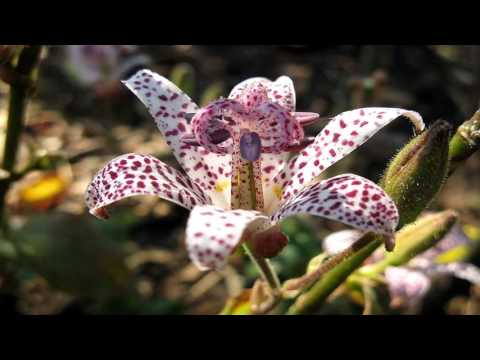

Watch this video on YouTube

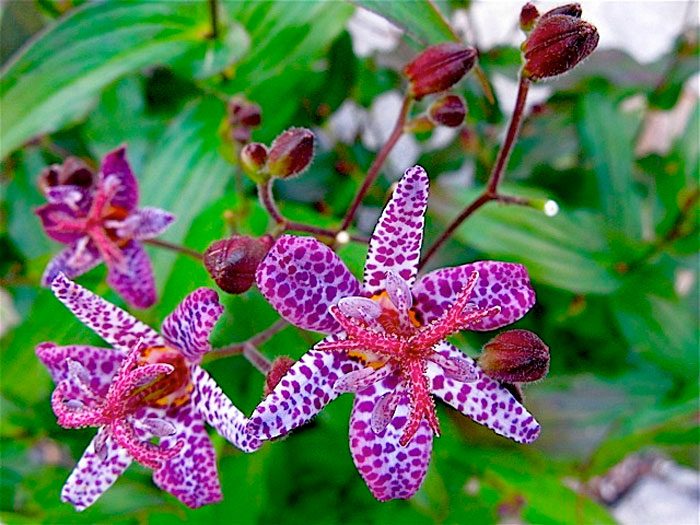
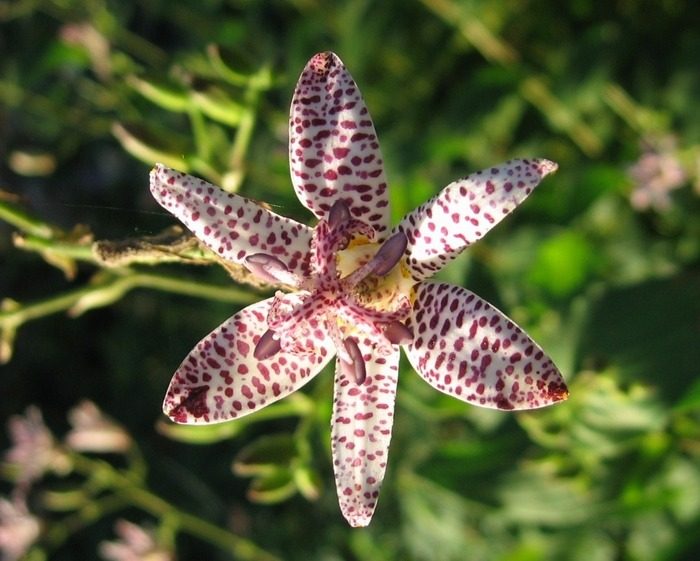
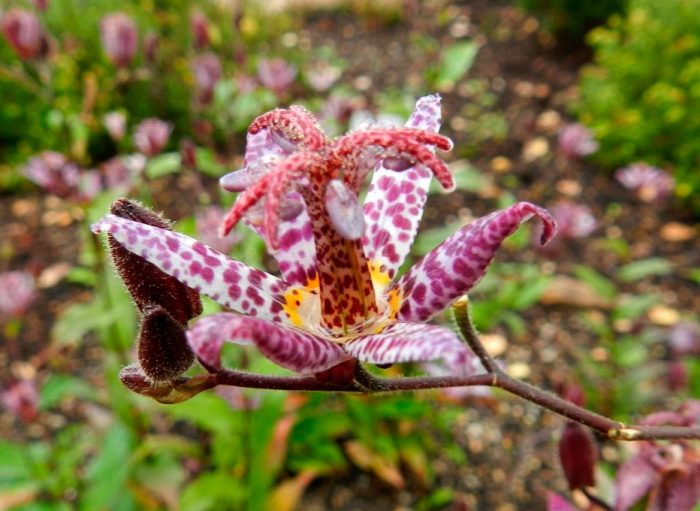
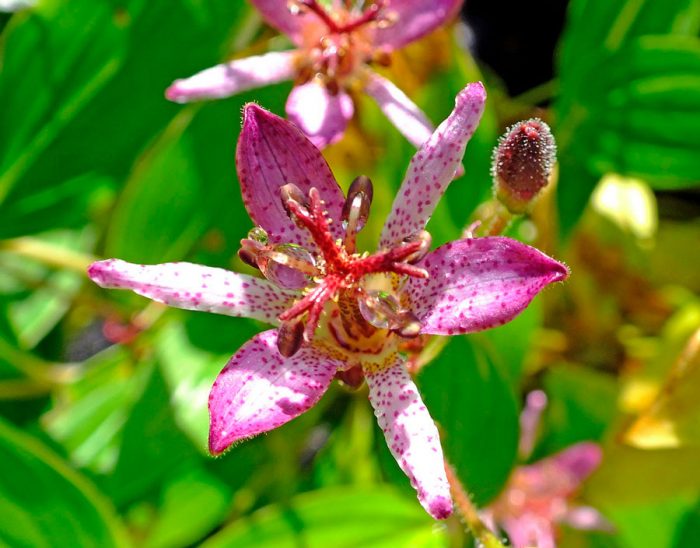
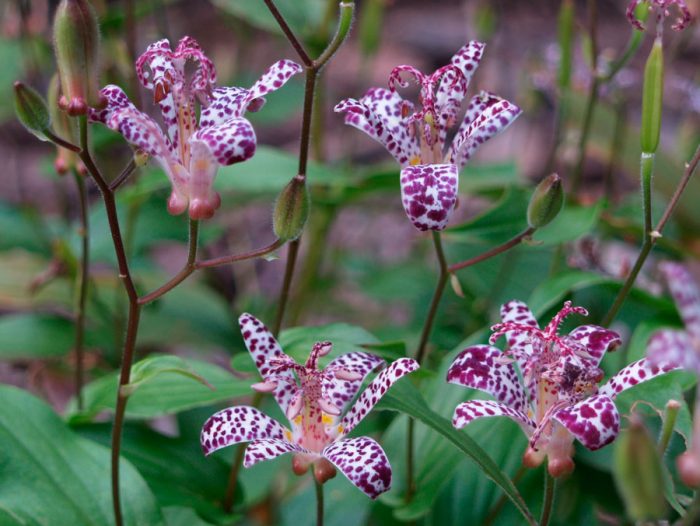
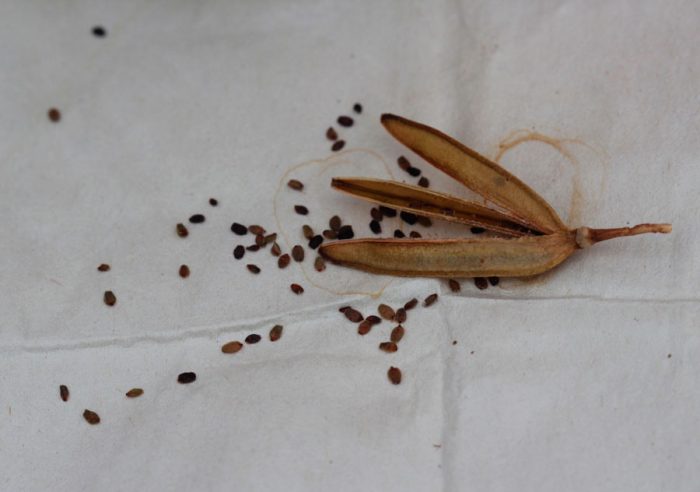
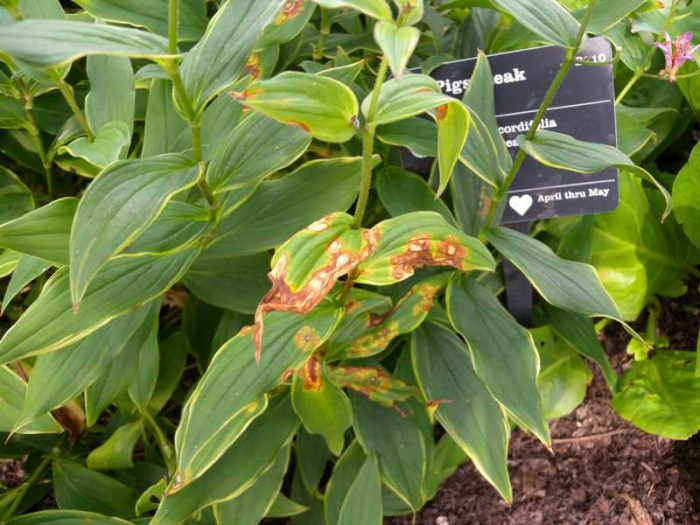
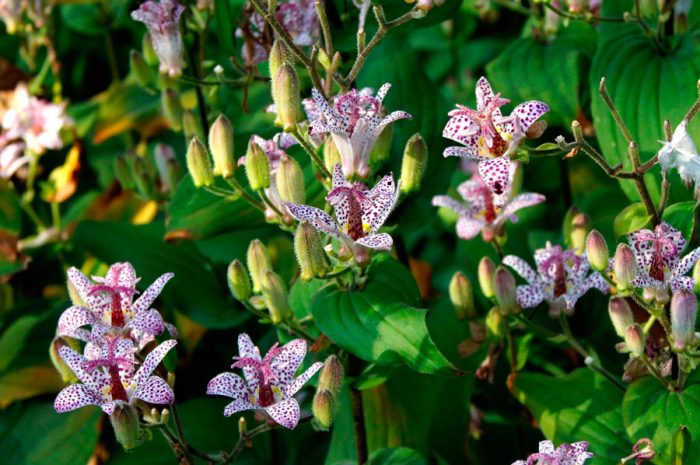
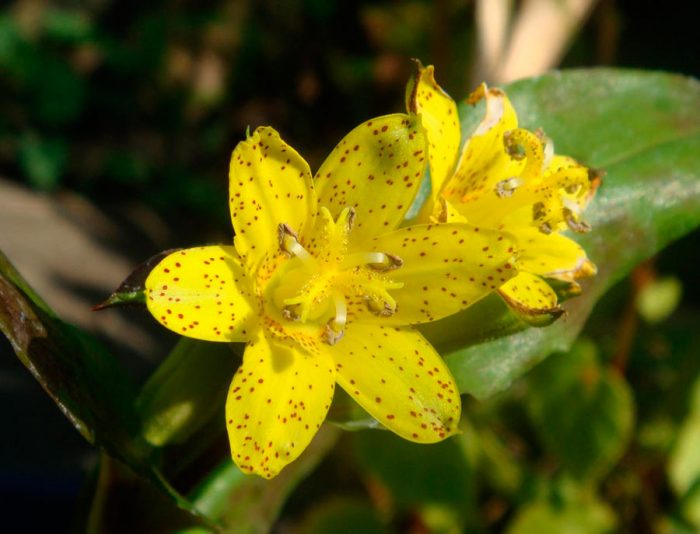

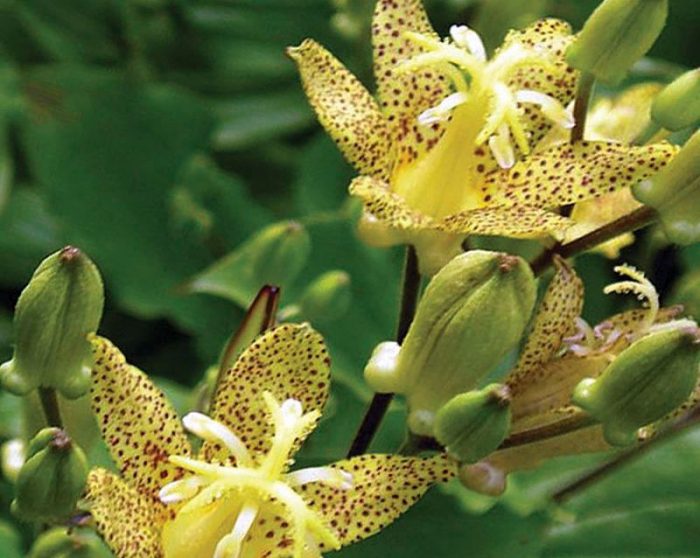
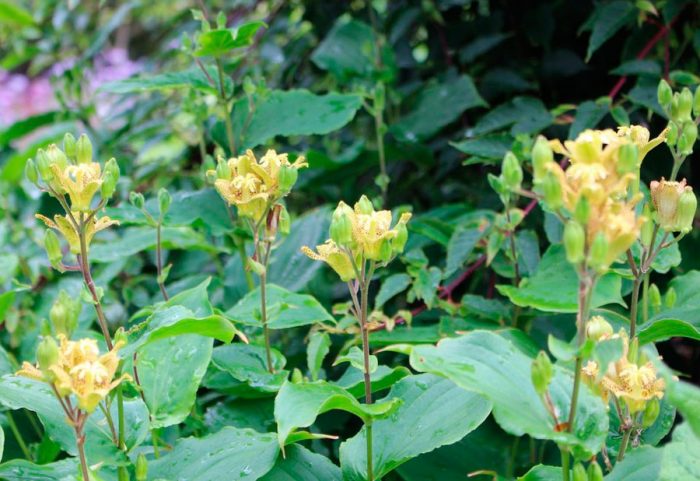

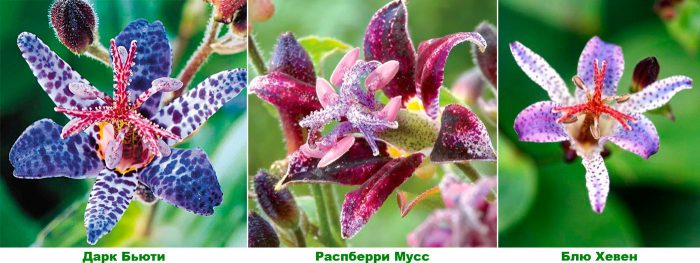
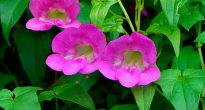
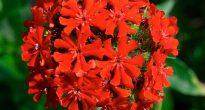



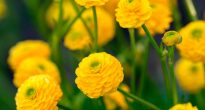




Everything is clear and interestingly said.